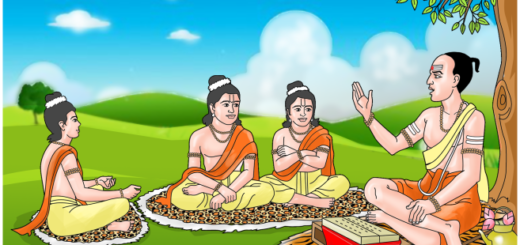Art & Culture: Indo – Islamic Architecture
Indo – Islamic Architecture
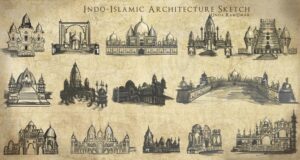
- Indo-Islamic architecture begins with the Ghurid occupation of India at the close of the 12 century A.D. The Muslims having inherited a wealth of varied designs from Sassanian and Byzantine empires and being naturally endowed with good taste for buildings, never failed to adapt to their own requirements the indigenous architecture of almost every foreign country that they conquered.
Contrasts and Resemblances
- The most important factors common to both forms of architecture, especially in respect of mosques and temples, were that to both styles, ornamental decoration was very vital and that the open court in many cases was surrounded by colonnades.
- But the contrast was equally striking: the prayer chamber of the mosque was spacious, whereas the shrine of the temple was comparatively small. The mosque was light and open, whereas the temple was dark and closed.
- The difference between the lay-out of a temple and a mosque is explained by the essential difference between the Hindu and Muslim forms of worship and prayer.
- A cell to house the image of the deity, garbha-griha, and often small halls in front for the worshippers was regarded adequate for a simple Hindu temple. But the Islamic form of worship, with its emphasis on congregational prayer, requires a spacious courtyard with a large prayer hall, pointed towards Mecca, as its western end that is, to the West of India.
- In the rear wall of the prayer-hall, the centre is occupied by a recess or alcove, called mihrab; and indicates the direction of prayer (quibla). A pulpit (mimber) at its right is meant for the imam who leads the prayer.
- A tower or minaret, originally intended for the muazzin to call the faithful to the prayer, later assumed a mere architectural character.
- A gallery or compartment of the prayer hall or some other part was screened off to accommodate the ladies who observed purdah.The main entrance to a mosque is on the east, and the sides are enclosed by cloisters (liwans). A tank is provided for ablutions usually in the courtyard of a mosque.
- You would have observed that this style of construction incorporated not only certain new modes and principles but reflected also the religious and social needs of the Muslims. The Muslim style of construction was based on arches, vaults and domes, on columns and pyramidal towers or slender spires, called trabeate.
- Although there exists some evidence to suggest that the true arch may have been known in India earlier, it is the Muslims who are believed to have brought the principle of building a true arch so as to hold up the roof or ceiling or a top part of a structure, the bricks or stones laid to reproduce a curve, held together by the key-stone on the top of the rise.
- The result was that flat lintels or corbelled ceilings were replaced by arches or vaults, and the pyramidal roof or spire by the dome. The necessity of raising a round dome over a square construction introduced multiplication of sides and angles by providing squinches so that a base with many sides usually 16, could be obtained to raise a circular drum for the dome.
- A sunshade or balcony was laid on cantilever brackets fixed into the projection from the walls, which introduced the chajja (caves or sunshade). The practice of the burial of the dead, as distinct from the cremation practised by the Hindus, chamber, a mihrab in the western wall and the real grave (qabr) in an underground chamber.
- In larger and more complex tombs, there is also a mosque, and well planned garden. The mode, theme or motifs or ornamentation employed in Islamic buildings also made a departure from the earlier vogues. The Hindu style or ornamentation is largely naturalistic showing human and animal forms and the luxuriant vegetation life.
- As among the Muslims the representation of living beings was taboo by way of decoration or ornamentation, they introduced geometrical and arabesque patterns, ornamental writing and formal representation of plant and floral life. In short the contribution of the Muslims to Indo-Muslim architecture is profound and no less interesting.
- Among the architectural features introduced by them mention may be made of arches, domes, minars and minarets, the pendentive, squinch arch, half domed double portals, kiosks (chhatris) and the use of concrete as a factor of construction. They also introduced gilding and painting in varied colours and designs. Muslim decorative elements are usually of the nature of embroidery.
- Even though lime was known and to certain extent used in construction work in India fairly early, mud was generally used for brick work and large blocks of stones were laid one on top of the other and held by means of iron clamps.
- The Muslims, like the Romans, were also responsible for making extensive use of concrete and lime mortar as an important factor of construction and incidentally used lime as plaster and a base for decoration which was incised into it and held enamel work on tiles.
- The building material obtained from the destruction of other buildings was used for new improvised buildings such as Quwwatul-Islam Mosque in Delhi and the Adhai din-ka-Jhonpra at Ajmer.
- As such from the 7th century to the 16th century Muslim architecture in India reflects the unsettled condition of the conquerers who felt that they were living amidst the conquered inhabitants, many of who were hostile to them.
- As such the accent thus far was on security which could be had only in walled fortifIcations. It is, therefore, that early Muslim towns and cities, even when they are tombs were made as fortified places which they could easily defend against hostile forces.
- The Quwwat-ul-Islam Mosque was constructed by Qutub-ud-din Aibak around 1197 A.D. and as is very clear from inscriptions he demolished 27 Hindu and Jain temples within the Rajput citadel of Lalkot as well as the Quila-Rai Pithora and that their carved columns, lintels, ceiling slabs, all showing Hindu gods and goddesses, Purnaghatas and temple bells handing by chains, were utilised to construct the mosque known as the Might of Islam”.
- In front may also be seen the Iron pillar in circumference. An inscription on it, engraved in characters of the 4th century A.D. proclaims it to be Garudarwaja, the lofty named Chandra believed to be none else than Chandragupta II Vikramaditya. Even though this pillar has been standing there for over 1600 years it has not been corroded by rust and is a standing testimony of the metallurgical skill of its manufacturers.
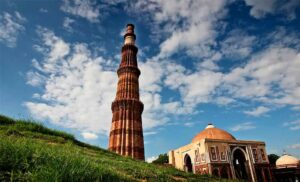
- The Qutub Minar of Mehrauli was built around 1199 by Qutub-ud-din and finally completed by his son-in-law and successor IItutmish (1210-35). In one sense this tower was raised in adjunct to the mosque to allow the mulah to call the faithful to prayer: it could also be a tower of victory, not unlike some erected by Hindu rulers. Originally the minar had four storeys, the uppermost of which was damaged by lightning in 1373. Feroz Shah Tughlaq (1351- 88) rebuilt its two storeys. With its projecting balconies, carved with decorated elements on the underside, inscriptional surface carving and variegated fluting, this 72.5 m. high minar with 399 steps, is the highest stone tower in India.
- Another early mosque, is the well known Adhai-din-ka-Jhonpra at Ajmer which was also constructed from the material obtained after demolishing Hindu temples. This one is also laid on the same plan as the Delhi mosque constructed by Qutub-ud-din, with carved pillars used in colonnades.
Adhai-din-ka-Jhonpra
- The Sultan Ghari tomb is situated 4 miles west of the Qutub and is the first example of a monumental Muslim tomb in India. It stands like a fortress within a walled enclosure with bastions on the comers, with its octagonal grave chamber underground. This also has a number of stone pillars, carved lintels and other pieces originally used in temples, re-utilised here by chipping off the Hindu decorative

Adhai-din-ka-Jhonpra
elements.
- The Alai-Darwaza was, built by Allaudin Khilji by enlarging the Quwwat-ul-Islam Mosque’s enclosures of colonnades and providing them two gateways. In this and other buildings constructed by the Khiljis, the true arch in the form of a pointed horseshoe, broad dome, recessed arches under the squinch, perforated windows, inscriptional bands and use of red sandstone relieved by marble are features characteristic of Khilji architecture.
- The buildings constructed in Delhi by the Tughlaqs such as the fortified town of Tughlaqabad – look solid, surrounded, as they are, with bastions, thick and sloping walls, even in the case of tomb of Ghiyas-ud-din Tughlaq, making them into fortified strongholds set in the middle of a moat, to make them unassailable. The buildings have plain and austere surfaces of grey stone, cross vaults over large halls, battered wall of enormous thickness, secret passage and hidden exits, everything built with an eye on defence. To a certain extent the Hindu trabeated construction is still used; there are false arches and the dome is a typical importation from Syria and Byzantine.
- From the Khilji and Tughlaq styles discussed earlier ultimately many of the Islamic tombs evolved through the next century or so, characterised by elegant verandahs consisting of multiplication of arches and a high tomb, derived and imported from western countries.
- In the course of these centuries the battlement motifs (Kangura) became a mere decorative element motif having outlined its utility as a defensive architectural member. There was gradually a harmonious blending between the Hindu and Muslim architectural styles and this new style of architecture is known as Indo-Islamic.
- It is entirely different in character from Muslim architecture in other countries, incorporating the best of both Hindu and ,Muslim styles, freely using Hindu brackets in an arcuate construction with a dome, with the difference that the Muslim dome now acquired a lotus design under its ftnial.
- It was in this direction that the Indo-Islamic Architecture now began to evolve, adding to it the local flavour of the provisional kingdom of Bengal, Gujarat, Jaunpur, Golconda, Malwa and the Deccan.
Bengal
- The Islamic monuments of Bengal are not much different from such buildings elsewhere in plan and in design, but the use of a different building material and the execution of details inspired by local traditions have made them quite distinct.
- The so-called “Bengal” roof with sloping cornices, which originated from the bamboo-construction, was adopted by the Muslims and later it spread widely, even in other regions.
- Brick was the chief building material in the alluvial plains of Bengal from early times and remains so even now, the use of stone being limited largely to pillars which were mainly obtained from demolished temples.
- The pillars in Bengal, even when constructed with brick, are generally short and square and the opening is usually accurate, for trabeate construction normally called for the use of stone. Covered brick and glazed tiles were usually pressed into service for decoration.
- At Gaur the earliest building representing the constructional and ornamental methods of this style, is the Dakhil Darwaja built by Barbak Shah (1959-74) as a ceremonial gateway in front of the citadel. With a tall arched entrance between vertical pylons on either side and tapering towers on the corners, it is an imposing structure.
- The walls of Sidi Said Mosque, Ahmedabad, built in 1572 consist substantially of perforated screens. It has become world famous on account of perforated screens, some of them representing the “palm and parasite” motif, which occurs also in the Darsbari Masjid in Bengal. It has the delicate quality of filigree work.
Bijapur 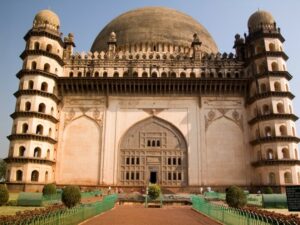
- The Gol Gumbad of Bijapur is the mausoleum of Muhammad Adil Shah (1627-57). It is the largest dome cubicle in the world covering a total interior surface of over 1600 sq. metres.
- Architecturally it is a simple construction, its underground vaults consisting of a square grave chamber and a large single square chamber above ground. The large hemispherical dome surmounting it and then seven storeyed octagonal towers on its corners lend it a unique appearance. A 3.4 m. wide gallery rests on its interior at the level of the drum. It is known as the whispering gallery, as even a whisper here reverberates as an echo under the dome. The large dome is hemispherical but is covered with a row of petals at the base.
Evolution Under the Mughals
- With advent of the Mughals, Indo-Muslim architecture got a blood transfusion as it were, architectural activity having declined significantly during the role of the Lodis.
- The Mughals were quick to realise that they could not hope to establish a lasting empire in India unless they took within their fold, mixed and mingled with the local population, especially the Rajput princess of Rajasthan.
- The Mughals turned deliberately towards conciliation and pacification of the Hindus. Akbar, did everything possible to live in peace and amity with his Hindu subjects. His policy of conciliation, his open admiration of Hindu culture and his unorthodox ways as the creator of a new eclectic religion, the Din-i-illahi, are reflected in architecture.
- Jahangir was half Hindu by blood, his mother, Jodhabai, being a Rajput princess. Shahjahan too continued this policy of tolerance and respect for the Hindus.
- The Mughal empire, as well as Mughal architecture, flourished and rose to great heights under their benign rule, but all this ended abruptly under the last of the great Mughals,
- Aurangzeb, a puritanic Muslim, who tried to reverse the entire conciliatory policy of his ancestors. He looked upon art, music, dance, painting and even architecture as an evil born of worldly desire and therefore there was an abrupt decline and eventual downfall in aesthetic appreciation and architectural enterprise.
- Babar, the founder of the Mughal empire, was a man of culture and exceptional aesthetic taste. For 4 years he ruled in India most of his time was spent in war. However, he was fond of formal gardens and a couple of gardens are ascribed to him. No architecture worthy of note was made during his times except perhaps a couple of mosques.
- After Babar’s death, his son, Humayun, succeeded him but he was driven out of India by Sher Shah Suri and after taking asylum in Iran, he eventually returned and overthrew Sikander Shah Sur, and regained his throne.
- To the Surs is ascribed, the tombs at Sasaram, in Bihar including Sher Shah’s own tomb, which was made by moderating the Lodi octagonal pattern with a verandah around it, each side pierced by arches and the halls surmounted by a large and wide dome. The Surs made use of red and dark grey stone latticed screens, decorative turrets, painted ceilings and coloured tiles.
- The Purana Qila and the Quila Kohna Masjid inside, are also ascribed to Sher Shah Suri. The walls of the Purana Quila are made of enormous half fashioned stones, with strong and thick walls, ornamentation and decoration are minimal.
Architectural Marvels under Mughals
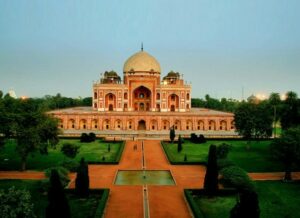
Tomb of Humayun
- The first distinct example of proper Mughal architecture inspired by Persian architecture, is the tomb of Humayun, in Delhi, built by his widow, Begha Begum.
- This tomb is important for a proper study of the development of later Mughal architecture and has provided the prototype, followed by architects who designed the Mausoleum of Jahangir at Shahdara, Lahore, as well as the celebrated Taj Mahal, at Agra.
- Although Sikander Lodi’s tomb as the first garden tomb built in India, it is Humayun’s tomb which strikes a new note.
- It is a memorial erected by a devoted wife for her imperial husband and is magnificent, grand and impressive. Raised on a vast platform, the tomb proper stands in the centre of a square garden, divided into 4 main parts by causeways (Charbagh) in the centre of which ran shallow water-channels. The square, red, sandstone, double storeyed structure of the mausoleum rises over a high square terrace, raised over a series of cells which are like a musical composition.
- The octagonal form of the central chamber containing the cenotaph, is inspired by Syrian and earlier Islamic models. It is for the first time that pink sandstone and white are used with admirable effect, the white is used cleverly to emphasise, surround and underline doors and windows, strengthening the design.
- There is a certain rhythmic quality in the whole structure in its symmetrical design and the repetition of the large dome in the similar pavillions with small but similar domes. The mausoleum is a synthesis of Persian architecture and Indian traditions, in the arched alcoves, corridors and a high double dome as well as the kiosks (chhatris) which give it a pyramidal shape from a distance.
- The tomb stands as a loving creation of a devoted wife for a great emperor, an intrepid warrior and a strong man and is in character, solid and massive.
- Akbar was keenly interested in art and architecture and his architecture is a happy blend of the Hindu and Islamic modes of construction ornamentation.
- Akbar’s seat of Government was Agra, it is there on the banks of the river Yamuna, that he started the construction of his famous Fort, made of red sand-stone, which was begun in 1565 and completed in 1574.
- This was the first time that depressed stone was used, also in the ramparts. With its high walls of neat sandstone facing the gateways, flanked by bastions, large halls, palaces, mosques, bazars, baths, gardens and houses for courtiers and noblemen, the fort at Agra laid a pattern in the construction of royal citadels that became a model for later ones.
- The Akbari Mahal and the buildings, along with the great and original city of Fatehpur Sikri, are made of red sandstone with trabeated construction and restricted ornamentation. The jambs, brackets, corbels and lintels of the doorways of the Jahangiri Mahal together with a Chajja above the doorways are profusely sculptured.
Fatepur Sikri
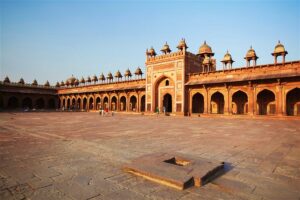
- Fatehpur Sikri was a town planned as an administrative unit consisting of public buildings as well as private residence in close proximity. The city of Fatehpur Sikri was founded as a token of gratitude to Sheikh Salim Chisti who had foretold that Akbar would have three sons who would survive after the sad demise of many children in infancy.
- The city was begun in 1569 and completed in 1574, the same year in which the fort at Agra was completed. The city is a modest and compact township, consisting of halls, palaces, offices, gardens, pleasure-resorts, baths, mosques, tombs, all of them little gems of architecture, making a town of great nobility. Almost all the structures are based on trabeate construction.
- The most typical and the most well known building is Panch Mahal, the highest and the most impressive structure, called the palace of five storeys. It is based on the Hindu system of trabeate structure, consisting of pillar, architrave, and brackets, with the only exception of the topmost domed pavilion, purposefully thrown out of the centre that crowns the entire building.
- The Diwan-i-Khas or Hall of Private Audience, is of a unique design. It is a square chamber with three openings on each side and a richly carved column in the centre supporting a magnificent flower shaped capital.

- Thorough ventilation is provided by placing on all sides perforated windows opposite each other on every wall. The charming balcony supported by a circular top capital, runs round the halls whole length of the 4 sides on the first floor level, supported by brackets. It is believed that the central place was occupied by the Emperor’s throne while his Ministers sat at the corners or on the peripheral passage.
- The Jama Masjid at Fatehpur Sikri, besides being very large and imposing, has also a high gateway on the south side called Buland Darwaja, which was added after Akbar’s victory over the Deccan. It is a semi-octagonal projection, containing a high arched alcove, and is perhaps the highest and the most imposing gateway in India.
- Only one building at Fatehpur Sikri is built of white marble, the tomb of Sheikh Salim Chisti, Akbar’s spiritual preceptor. It is a square chamber, having a screened verandah, containing latticed panels of exquisite design, and is an elegant structure. Besides completing Akbar’s tomb at Sikandara, and also constructing the Musamman Burj, a double storeyed pavilion on the Agra fort, with beautiful inlay, Jahangir’s queen, Nur Jahan, built the most important building in Agra the tomb of Itmad-ud-Daula, her father and the Prime Minister of Jahangir, by name Mirza Ghiyas Baig.
- On the upper storey there is a pavilion with rectangular dome and screens enclosing the false grave
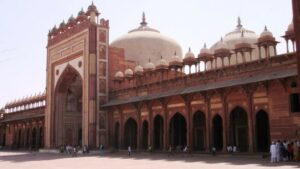
Jama Masjid
of Itmad-ud-Daula and his wife. The structure is built of white marble and is richly decorated with delicate inlay work and painting containing the characteristic Persian motifs such as cypress trees, vases fruits, winecups, etc.
- The minarets on the four corners, and the fine lattice work, traceries and inlay are in many ways, precursors of similar decorations later on perfected and employed in the Taj Mahal.
- Shahjahan was the greatest builder of the Mughal dynasty and with him architecture was a passion. He looked upon white marble, expensive and splendid, as the right and proper building material for an emperor of Hindustan.
- By this time the Mughal artistic tradition had matured and refined to a great extent. It was during Shahjahan’s time that there was the highest efflorescence of Mughal architecture in India. As against the sturdy, robust and plain construction of Akbar, Shahjahan’s buildings are highly sensuous, delicate and feminine. Instead of the earlier simple relief work in red sandstone used by Akbar, Shahjahan’s buildings are full of delicate carvings in marble, almost like filigree and inlay with pietra dura work.
- The arch became foliated, the dome became bulbous with a constricted neck and pillars raised with shafts capitals. He even demolished some of Akbar’s simple pink sandstone structures in the Agra Fort and replaced them with more luxurious looking, magnificent marble building.
The Taj Mahal

- Besides constructing a number of elegant, lavishly decorated buildings, such as Khas Mahal, Diwan-i-Khas, Moti Masjid, as well as the Jama Masjid in Delhi, Shahjahan erected the most romantic and fabulous building, the Taj Mahal, the tomb of his beloved wife, AIjumand Bano Begum entitled Mumtaz Mahal.
- It is a dream in marble and is the logical culmination of the conception of a garden tomb, starting with Humayun’s tomb at Delhi.
- The Taj is a square tomb built on a raised terrace, with graceful tall minarets at its four comers.
- As in Humayun’s tomb, the tomb chamber is octagonal, with subsidiary chambers at the angles and the tomb is surmounted by a graceful double dome.
- The doorway is narrower and loftier, the dome is much more soaring. The dome has acquired a lotus pattern below with the finial.
- The Taj is noted for its ethereal and dreamlike lightness, graceful proportions and a harmonious balance between architecture and ornamentation.
- There is profuse carving and beautiful inlay work with precious multicolour stones in its floral and arabesque pattern, fme borders, inscriptions in black marble, delicate traceries and trellis work executed against the background of white marble. Like Humayun’s tomb it was laid in a charbagh, or gardens with water channels and full of flowers.
The Red Fort

- In 1638 Shahjahan shifted his capital from Agra to Delhi and laid the foundation of Shahjanabad, the Seventh City of Delhi, containing his famous citadel, the Red-Fort, which was begun in 1639 and completed after 9 years.
- The Red Fort is an irregular octagon, well planned, with its walls, gates, and a few other structures constructed in red sandstone, and marble used for the palaces.
- It consists of a Diwan-i-Am, containing the marble canopy ornamented with beautiful panels of pietra dura work showing a few paintings.
- Diwan-i-Khas is a high ornamented pillared hall, with a flat ceiling supported on engraved arches. Its pillars contain pietra dura ornamentation and the upper portion was originally gilded and painted. It is also said that its marble dais once supported the famous Peacock Throne.
- The exquisite marble screen containing a representation of the scales of justice and on the walls of this marble palace are Persian couplets, detailing the dates of the construction of the fort, the cost of construction and also the famous couplet claiming that “If there be a paradise on earth it is this, it is this, it is this”.
The Decline
- The luxury and love of constructing magnificent buildings, patronised by Jahangir and Shahjahan came to an end rather abruptly with the last of the great Mughals, Emperor Aurangzeb.
- Not many palaces of early Hindu rulers of medieval time have survived. Certain feature which characterise the Islamic construction were not coromed merely to Muslim forts, palaces, mosques and tombs, but were also incorporated by the Hindus, who made use of some of the indigenous features, and planned their building to suit their customs and ways of living.
- Rajasthan is rich in such palaces. The palaces built during the Mughal time may be different from each other in plan, but they have certain common architectural features, such as balconies supported on carved brackets, pillared kiosks crowned by domes, arcades of sunk arches, foliated arches, latticed screens, curved Bengal roofs and flat domes rising from a rectangular base. Situated as these palaces often are on rocky heights, they look very impressive such as those at Amber: Jaipur, Bikaner, Jodhpur, Udaipur, Jaisalmer, etc.
Contemporary Buildings
- The Kirtistambha, or Tower of Fame, was constructed by the Solanki ruler of Gujarat and one such is that of the Chittor Fort, the capital of Mewar before Udaipur. The tower, was constructed in the eight years following 1440 and restored in 1906 to commemorate the building of the Kumbhaswami Vaishnava temple, consecrated in 1440.
- Of many “experimental” works, in which the Hindu and the Islamic traditions had combined to create something novel is the interesting example of the ‘Hava Mahal’ (the Palace of the Wind) at Jaipur.
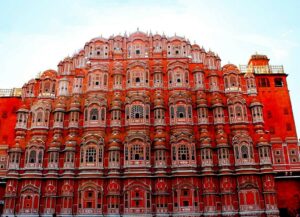
- Here an extraordinary experiment has been made to create a building suited to the hot, dry climate of Rajasthan, by making the entire facade a perforated screen by creating over fifty slightly raised pavillions, each a half oriel window, as it were, to allow little breeze to waft through those hundreds of perforated jali windows.
- These half raised pavilions are covered by little domes and curvilinear roofs, whilst the openings are arch-shaped. These are probably inspired by the tiers of small shikharas rising one above the other, of Bhubaneswar or Tanjore.


